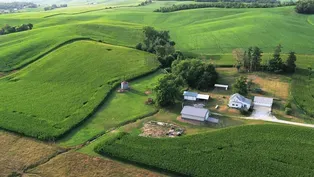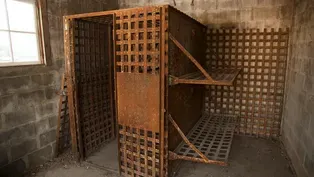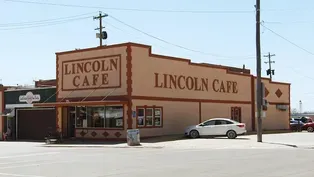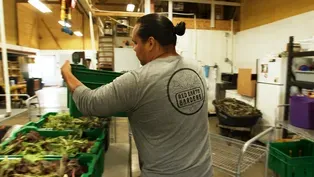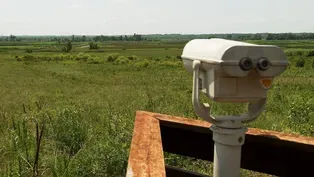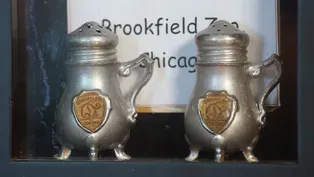
Amana Colonies
Clip: Season 1 Episode 107 | 6m 36sVideo has Closed Captions
A religious communal society is celebrated in seven villages of living history.
A religious communal society is celebrated in seven villages of living history.
Problems with Closed Captions? Closed Captioning Feedback
Problems with Closed Captions? Closed Captioning Feedback
Road Trip Iowa is a local public television program presented by Iowa PBS

Amana Colonies
Clip: Season 1 Episode 107 | 6m 36sVideo has Closed Captions
A religious communal society is celebrated in seven villages of living history.
Problems with Closed Captions? Closed Captioning Feedback
How to Watch Road Trip Iowa
Road Trip Iowa is available to stream on pbs.org and the free PBS App, available on iPhone, Apple TV, Android TV, Android smartphones, Amazon Fire TV, Amazon Fire Tablet, Roku, Samsung Smart TV, and Vizio.
Providing Support for PBS.org
Learn Moreabout PBS online sponsorship♪♪ Kohlsdorf: At its eastern end, the Iowa Valley Scenic Byway is anchored in the Amana Colonies, seven villages of living history, which tell the tale of a communal society of German immigrants.
Members of a Christian order called the Community of True Inspiration arrived in Iowa in 1855, seeking religious freedom and fertile land.
From Scripture, they chose the name "Amana," which means "remain true."
For almost 80 years, the Amana Colonies were an interdependent society, where property was shared, no one earned a wage, and the community provided for everyone's needs.
I'm here at the High Amana General Store, which has been around since 1857.
Today, it serves as both a gift shop selling artisan goods, and also a history museum.
Let's take a look inside.
♪♪ ♪♪ We are here with Kathie, and I'm just kind of in awe right now by the store.
It looks like we're walking back in time.
Is most of this original?
Absolutely.
Nothing has been changed in the store.
Everything's original from ceiling to floor.
The tin ceiling was unique because it came in 6-foot rolls and not the tiles that we're used to.
Counters and display cases are also original.
We've just turned them so you can go behind the counters all the way around the store.
We're doing it for our locally handcrafted products, but we also import our German Christmas decorations, and they come from a little village in Germany.
We have the little guys up here in front, and we keep the bigger ones in the back.
So we're walking back in time.
Take us back to the time when a lot of the Germans who were coming to the United States because of religious freedom -- tell us about the community that they helped create here in Amana.
Well, it was a communal organization, and it was, like I like to say, the Three Musketeers.
It was all for one and one for all.
They had communal kitchens.
They did not have kitchens in their homes.
I think High Amana had nine kitchens to serve because they could do 30 to 40 people, and they ate five times a day.
How is that way of living still present here in Amana today?
Well, we're proud of our area.
It's very scenic and serene, very quiet here, and our flowers and our garden still look [chuckling] very nice.
Church, of course, is something that we do together, and it's still done the old way.
We would be compared to a German Lutheran, but we're not.
Our religion is called the Community of True Inspiration.
Kathie, thanks so much for the history lesson.
Well, you're welcome.
Let's go see more of the Amana Colonies.
♪♪ Kohlsdorf: Today, the Amana Colonies are a National Historic Landmark, proudly displaying their brick and stone structures, charming lanterns, and colorful flower beds.
Hundreds of thousands of visitors travel to this part of Iowa each year to get a taste of a different way of life.
We bought in '07, and we brought in all Momma Joyce's recipes that we played with a little bit and made into large-batch recipes.
We call ourselves a grandma bakery.
We want everyone to feel like they're coming into Grandma's house, right at home.
Momma Joyce: The molasses cookies started in the 1800s with my great-grandmother.
And then just our recent -- took 12 years to develop -- is our new multigrain.
Thank you so much.
You have a great day.
-Thank you.
-Thank you.
Lockhart: We are at the Amana Meat Market.
It's been here since 1855.
Every village used to have their own butcher shop.
We're still in operation.
We have most of the meat brought in now, and then we just go ahead and use all the old-time recipes.
Kohlsdorf: As the communal society dissipated in the 1930s, the Amana community celebrated their heritage by sharing it with others.
Preserving the past while moving forward can be tricky, but the Amana Colonies have threaded the needle.
Dietrich: We're in the historic Amana Woolen Mill.
This woolen mill has been here for over 150 years.
The people who ran this came from Germany.
The Amana people brought with them many of the arts and crafts and trades that they learned in Germany, and one of them was weaving.
They originally raised sheep right here on the farm, and they sheared the wool off of the sheep.
They dried it, they dyed it, and they spun it into yarn.
Today, farmland is too valuable to raise sheep on.
So we buy our yarn already manufactured, and it goes to the warping and the weaving process.
And right now we are in front of the warping creel, which is the lengthwise threads on the blanket.
Kohlsdorf: How many blankets and other pieces do you make in a year?
We make about 5,000 blankets a year.
We're much more mechanized than we were back in the 1850s.
We can weave a blanket in about 3 minutes on computerized loom.
Why is it so important to keep a place like this alive?
I think it's very important.
I think keeping the history alive for the next generation...
They kept it alive for us.
We have multigenerational employees here, and to keep that alive -- so much of weaving has gone overseas.
Two or three woolen mills left in the United States.
There are a few cotton mills in the South.
But we are one of the few.
We are the only one left in the state of Iowa.
You know if you buy an Amana blanket, it's made right here.
So, Amy, this is the final step, correct?
Amy: It is.
This is where we put the Amana label on.
What's so significant about this label?
Part of it is that it has the logo, the Tree of Life logo, which all the Amana businesses have.
And it sort of, I think, you know, pulls together all the businesses and all the people who work here in the same way that they -- people were together when they first came.
It doesn't even seem like a blanket until this label goes on.
Video has Closed Captions
The hills along Iowa's Czech Trail have made generations of Bohemians feel right at home. (2m 25s)
Video has Closed Captions
Clutier's quaint old town jail is a great place to visit, but you may not want to stay. (34s)
Video has Closed Captions
For decades this cafe fed Lincoln Highway and rail travelers morning, noon and night. (3m 46s)
Meskwaki Nation's Red Earth Gardens
Video has Closed Captions
Meskwaki Nation's old ways of growing fresh food are preserved in a community garden. (2m 47s)
Video has Closed Captions
The Iowa River Corridor is home to a wide variety of wetland, grassland and wildlife. (3m 3s)
Traer Salt & Pepper Shaker Gallery
Video has Closed Captions
One woman's unique collection has shaken up the town of Traer for nearly 80 years. (3m 39s)
Providing Support for PBS.org
Learn Moreabout PBS online sponsorshipSupport for PBS provided by:
Road Trip Iowa is a local public television program presented by Iowa PBS
